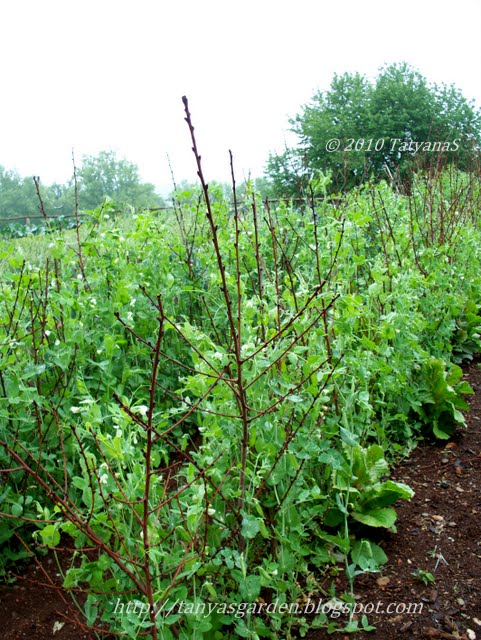Layout of a vegetable garden, type, shape and size of raised beds, type of mulch around them, support for climbing plants, containers for growing vegetables, ways to make vegetable gardens not only practical but also attractive and other aspects of vegetable gardening - this is what "Sprucing Up a Vegetable Garden" is about.
These three pictures prove that wooden boxes for growing vegetables can be attractive elements not only in a garden itself but on a deck too.

*
*
Wooden half-barrels, as in the next picture, make good vegetable planters. Miniature (compact, midget, dwarf) varieties of many types of vegetables are available nowdays (see a list of them here). Good information about growing veggies in containers can be found here .
Thick bamboo stakes are used to make a TeePee in this garden. Sprucing Up a Vegetable Garden-2 has more pictures with different types of supports for climbing plants .
*
*
*
Below, there are vegetable gardens in Alaska belonging to the members of the Homer Garden Club. My hat is off to you, the northenmost gardeners in the U.S.!
I've never seen potatoes growing on a terraced slope:
.
.
*
I noticed Nasturtiums as companion plants interplanted with vegetables in many gardens in Homer. I use nasturtiums in my vegetable garden too. Mine spread wildly, and need to be pinched to prevent them from taking over the whole garden. I might switch to more compact varieties of nasturtiums.
*
I use yellow, orange and red nasturtium flowers in salads and for decorating plates.
*
*
I always watch what is used as mulch in a garden especially around raised beds. Gravel? Wood (bark nuggets, chips)? Any mulch will help to prevent soil erosion and moisture loss, supress weeds, cool or warm the soil and encourage the worm population. What is your favorite material? Do you always put it 3 inches (7 1/2 cm) deep as they recommend?
*
In one of the gardens shown here, they use small river rocks and crushed rock. I like such a look. Gravel and rock seem to be more practical on slopes since they are not washed away as easily as wood mulch. I also like hay/straw as mulch, although they decompost fast and need to be replenished often. Saying that, I should admit that I stopped using it after one of my neighbors expressed a concern about straw attracting mice. It's true, rodents love this material as well as slugs which we have here, in the Pacific Northwest, in abundance. But, it was not them who turned me away from straw mulch but garden snakes. I have them in my garden anyway, but I don't like to step on them after they have found a refuge under hay or straw.
*
*
Some pros and cons of different types of mulches can be found here.
In the next picture - supporting raised beds with boards which are not made into frames. It should be convenient for changing the size and configurations of the beds.
*
In the next picture - supporting raised beds with boards which are not made into frames. It should be convenient for changing the size and configurations of the beds.
*
Wooden boards for practicality, plates for decoration - nice, nice, nice:
*
If in Homer, Alaska, a moose is often a garden visitor, in Washington state, a deer should be kept from the gardens. A fence is the most reliable way to do it:
.
It is expected for a vegetable garden belonging to a designer to be ... well, artistic!
.
.
Jody's husband made these raised beds based on her own design.
.
.
Below is the most decorative peas' support which I've ever seen:
.
.
The following two pictures are from Peggy's garden. She, by the way, also has an exquisite flower garden deserving to be featured in a separate post.
.
.
I love the mosaic urn in the middle of the bed. It can be seen in the picture in the very first "Sprucing Up a Vegetable Garden". "
.
.
*
I hope these pictures from the gardens generously opened to the public by their owners can help you make some decisions regarding your own gardens. There are numerous articles on the Internet about vegetable gardening. But sometimes seeing real gardens of ordinary people help us a great deal, don't you think so?
***Copyright 2011 TatyanaS






